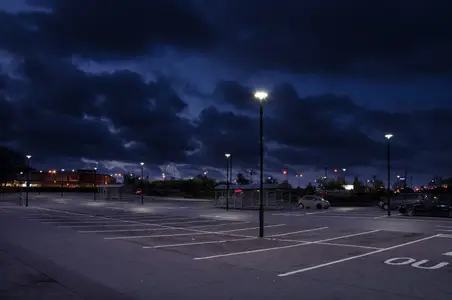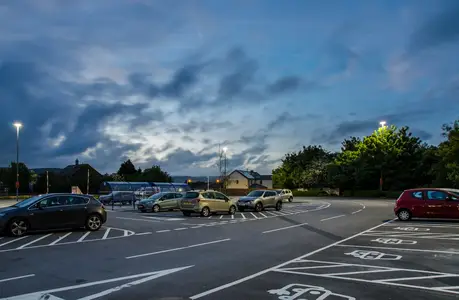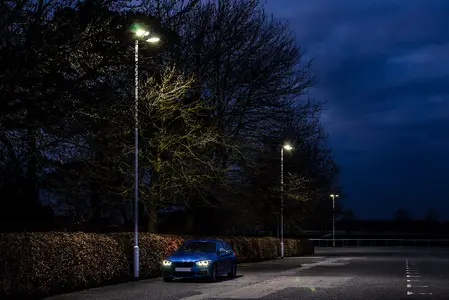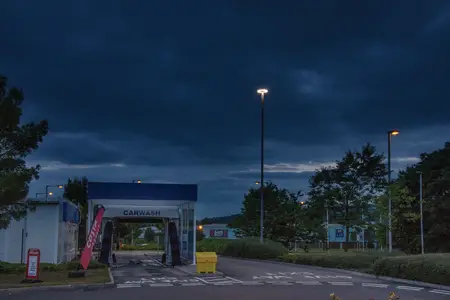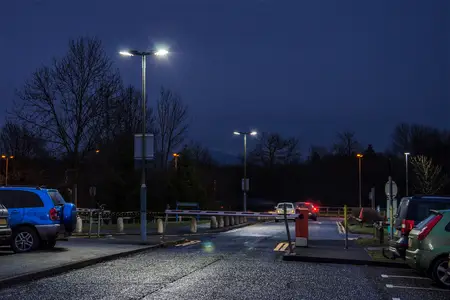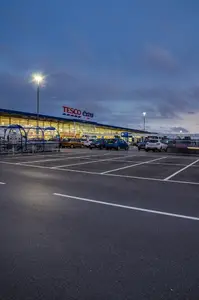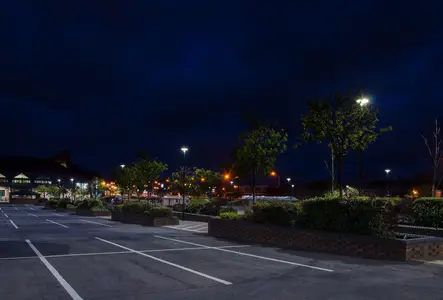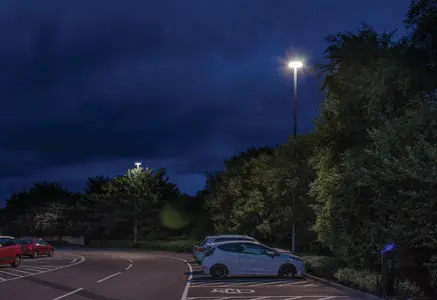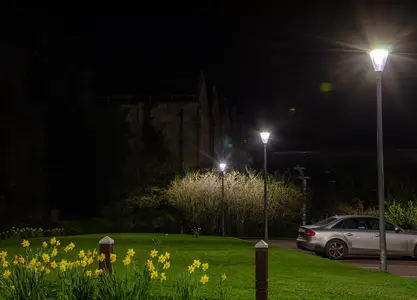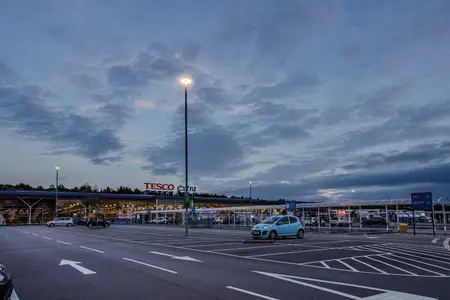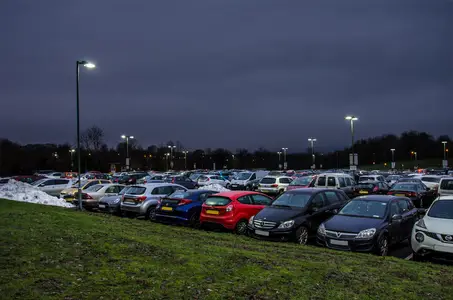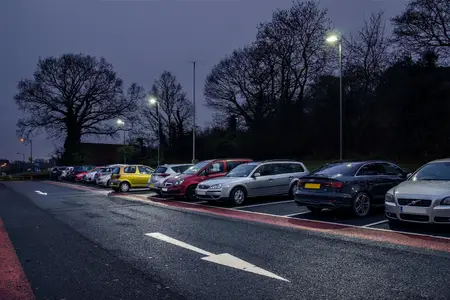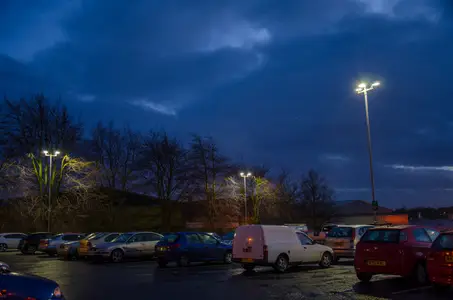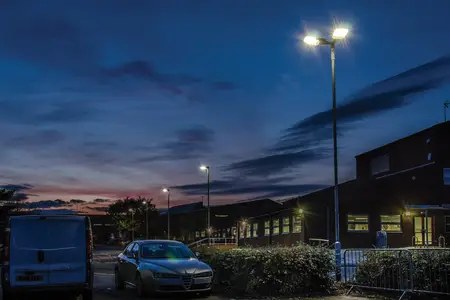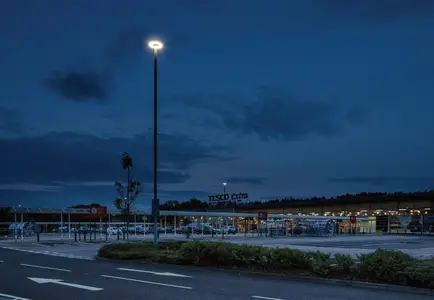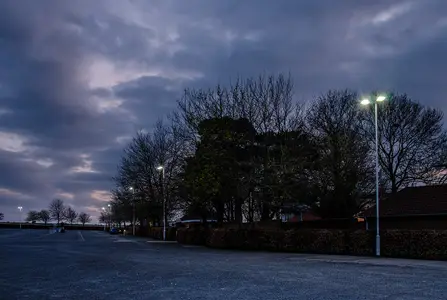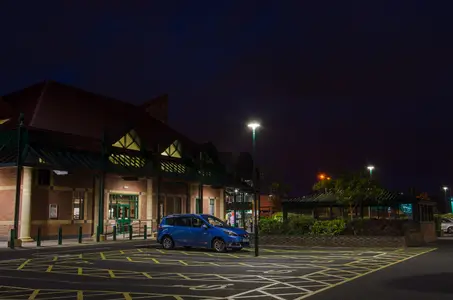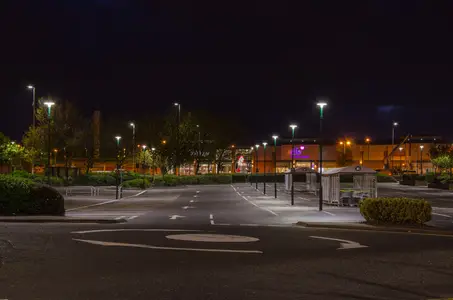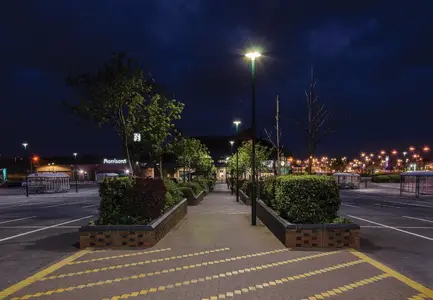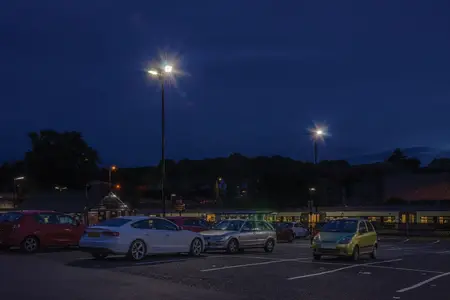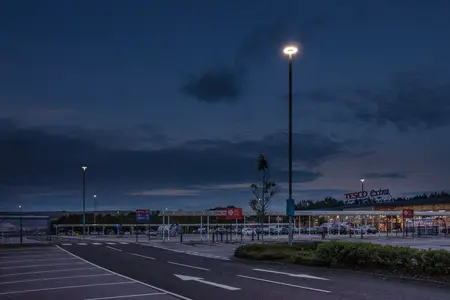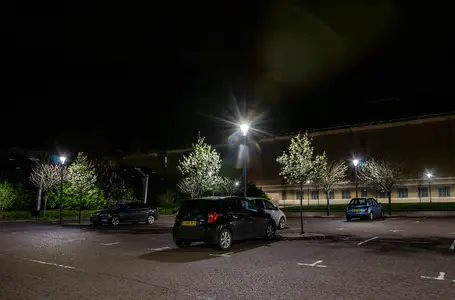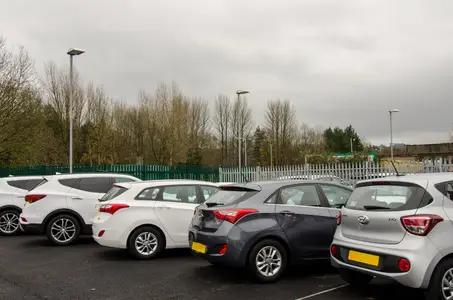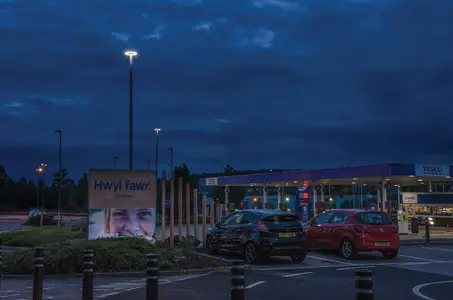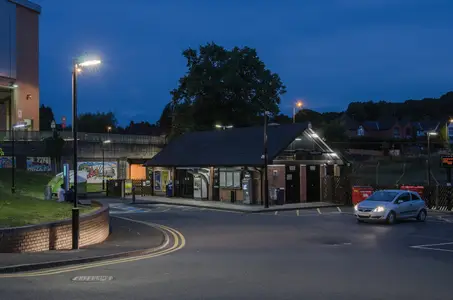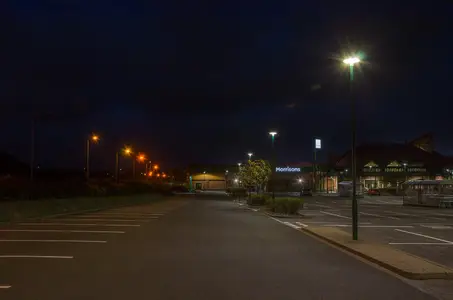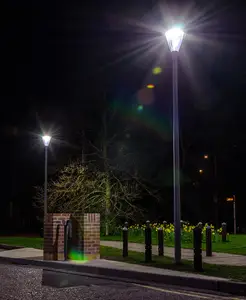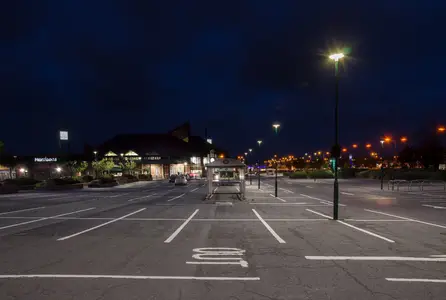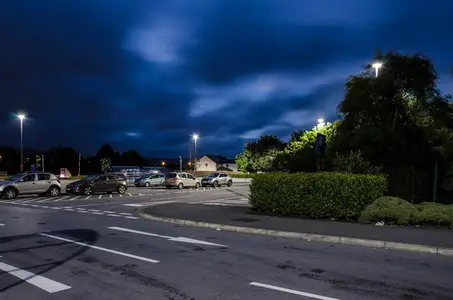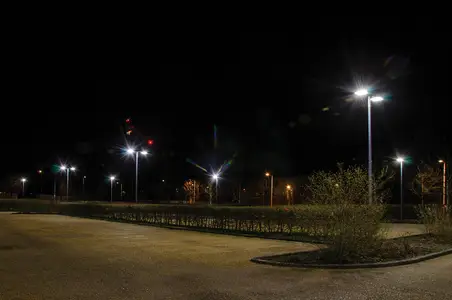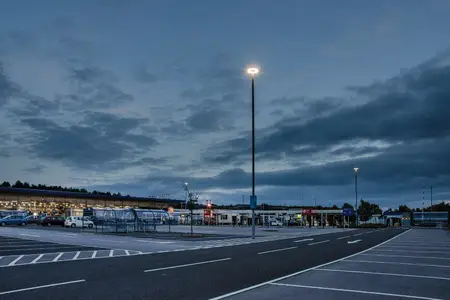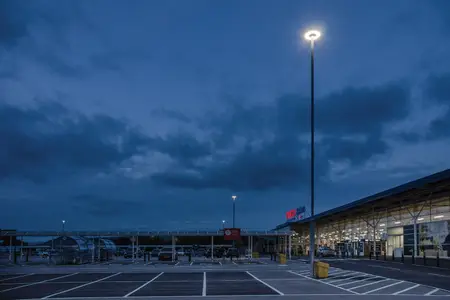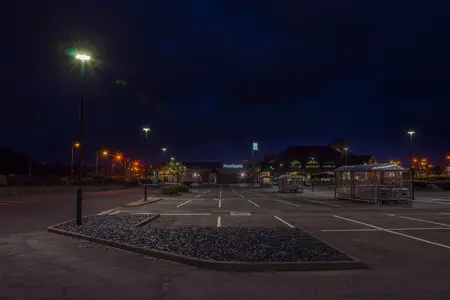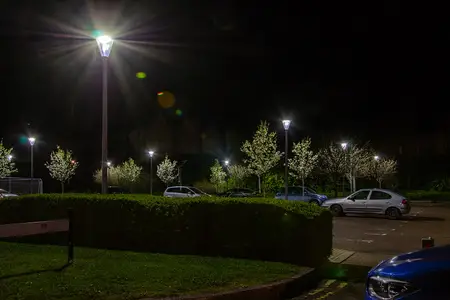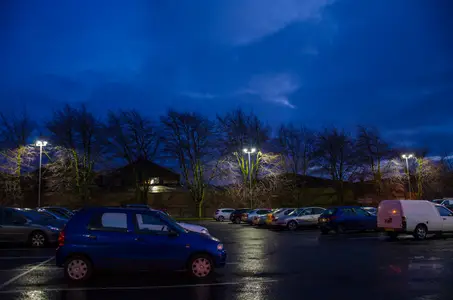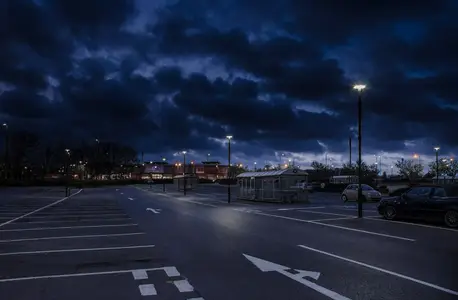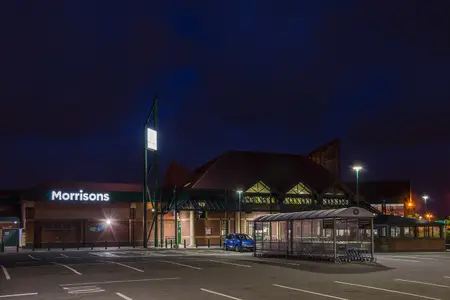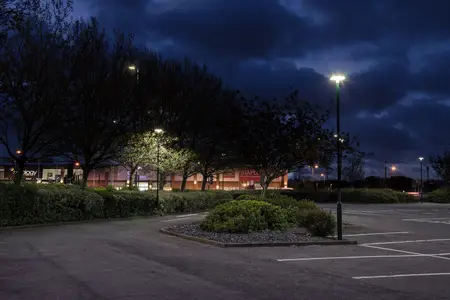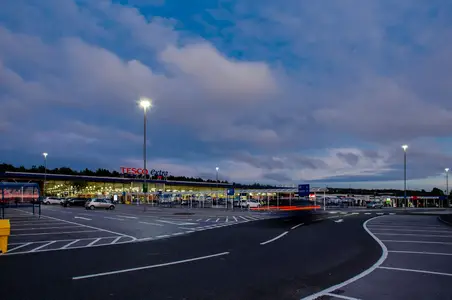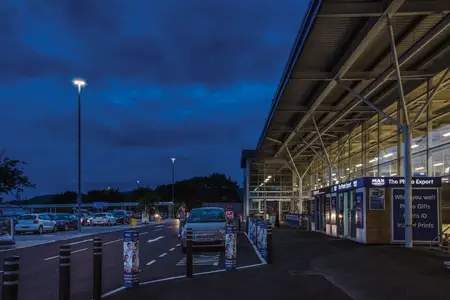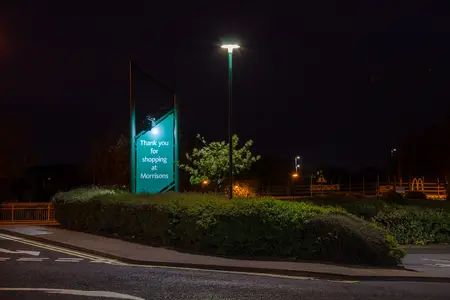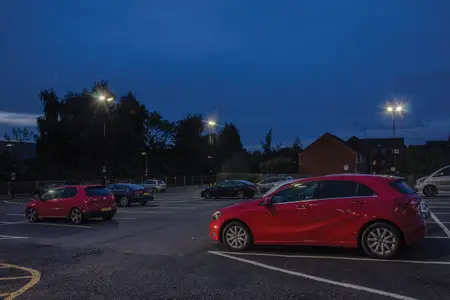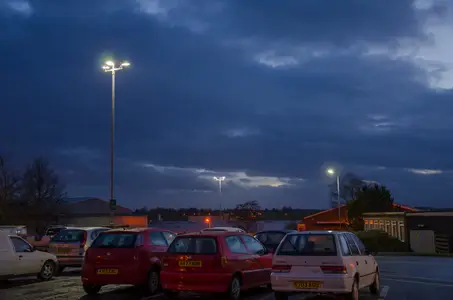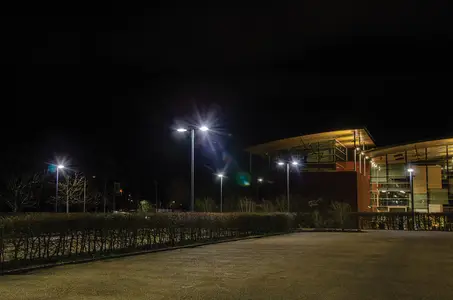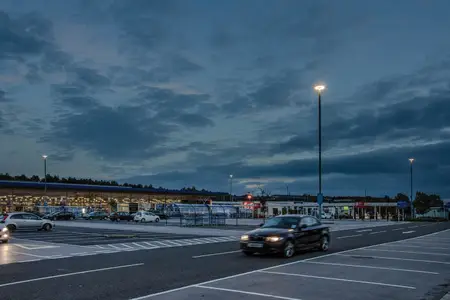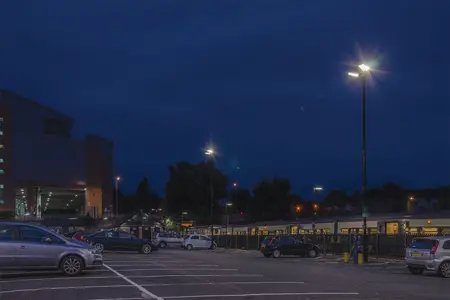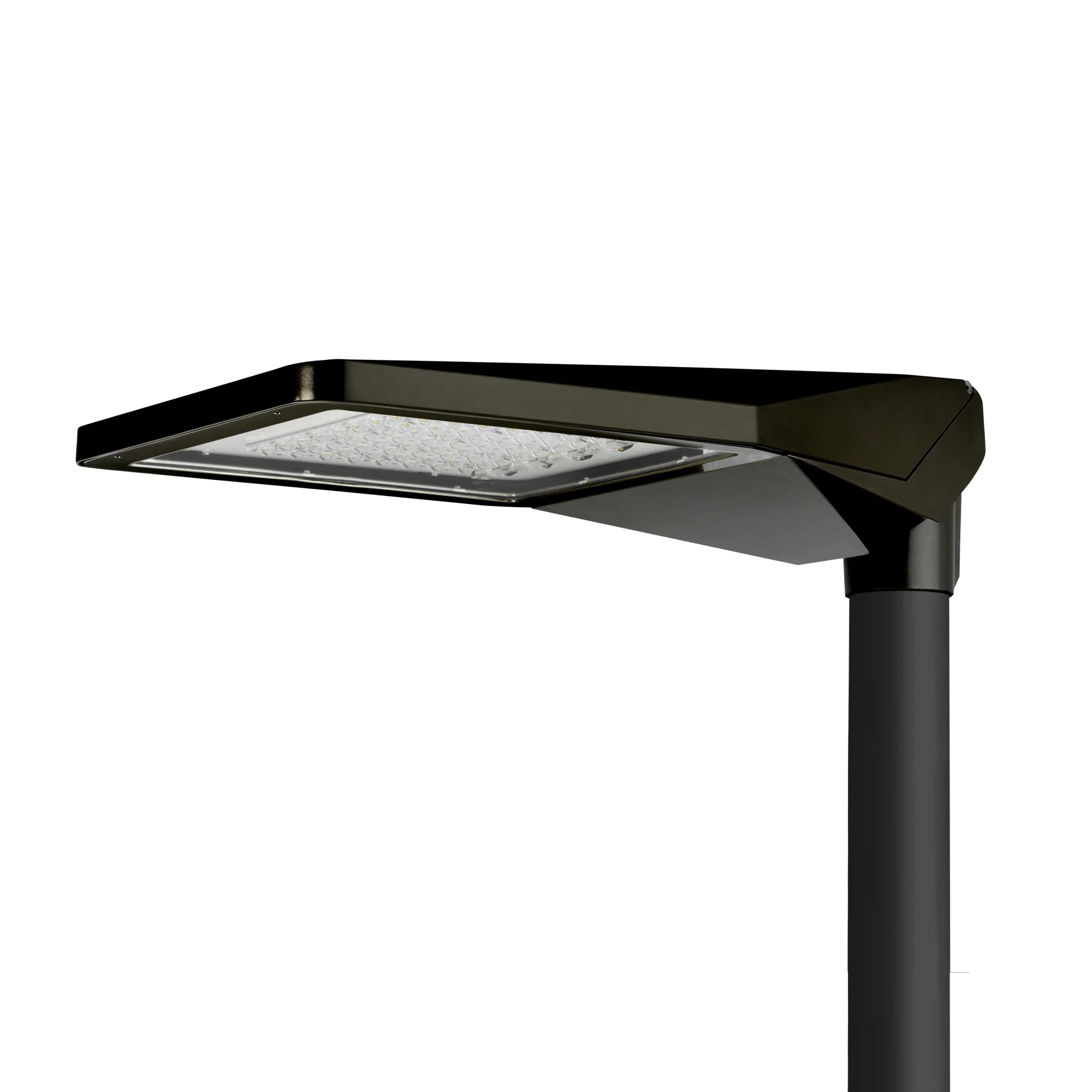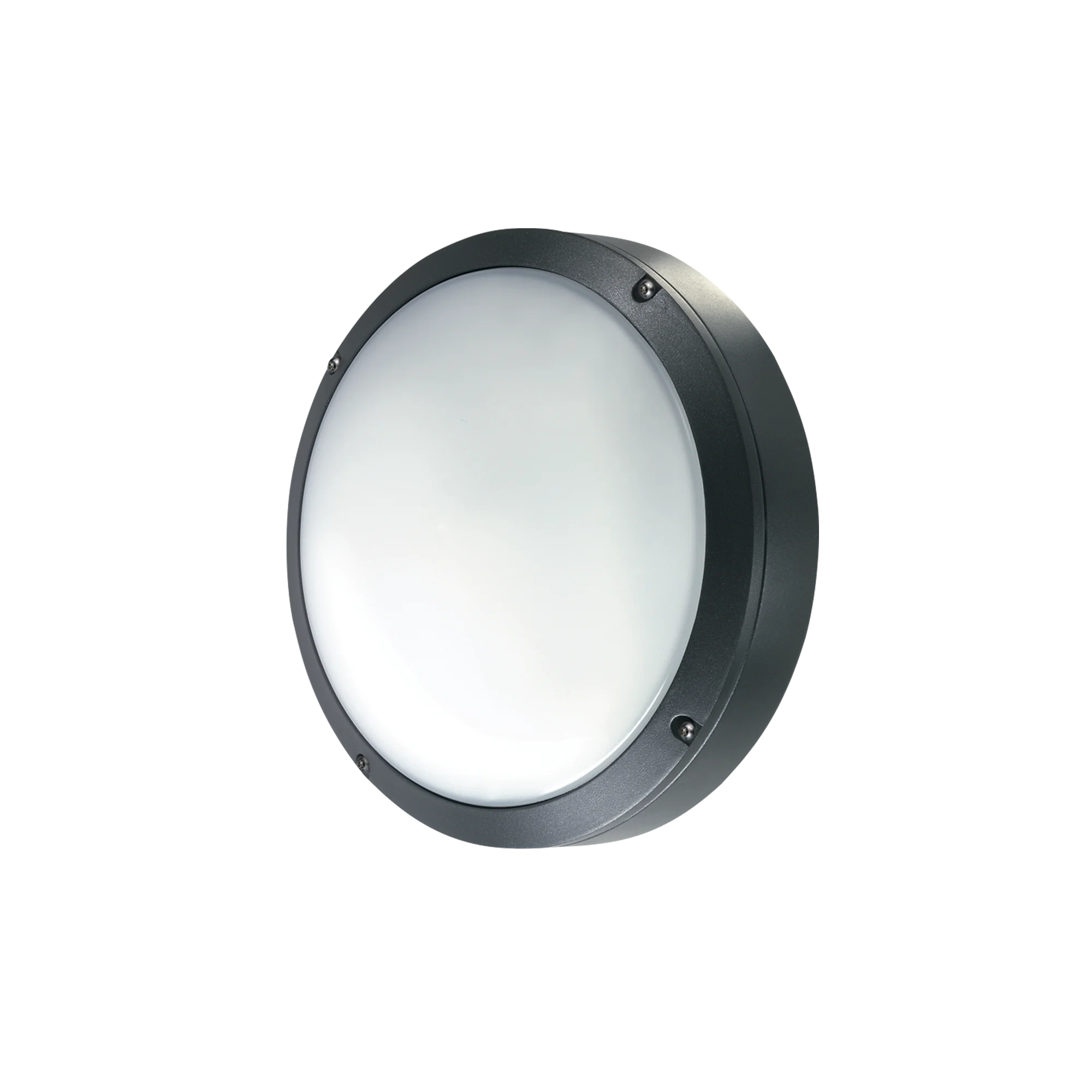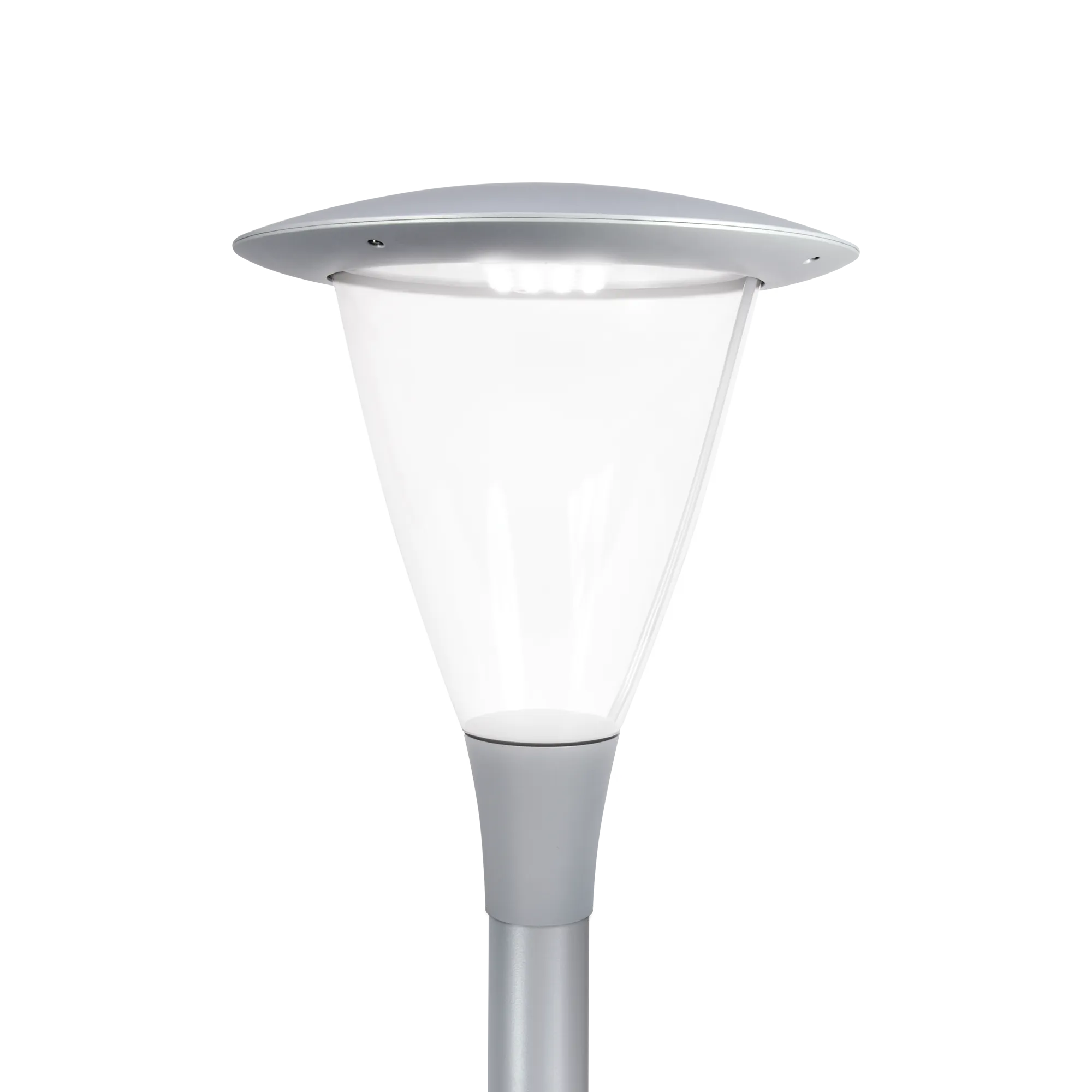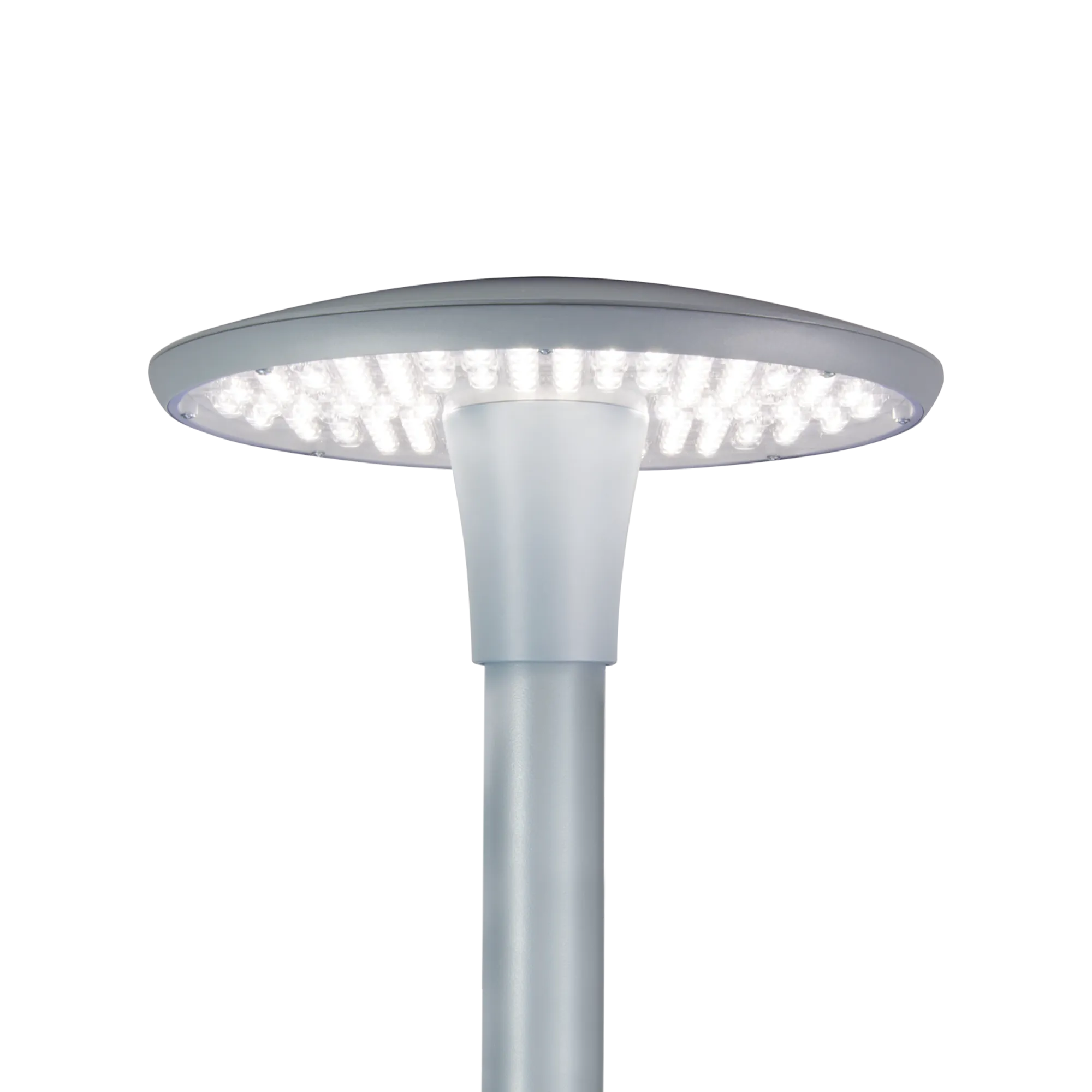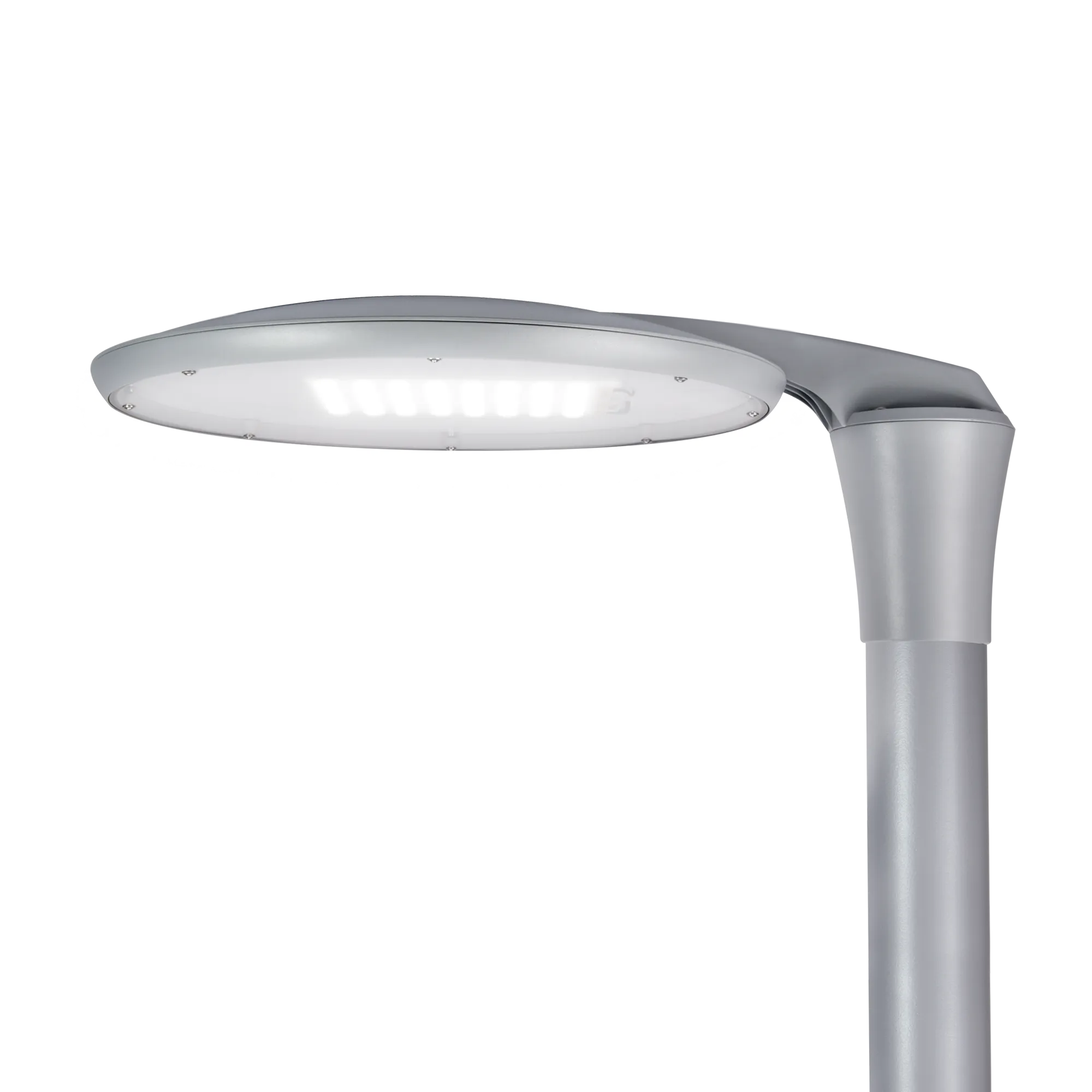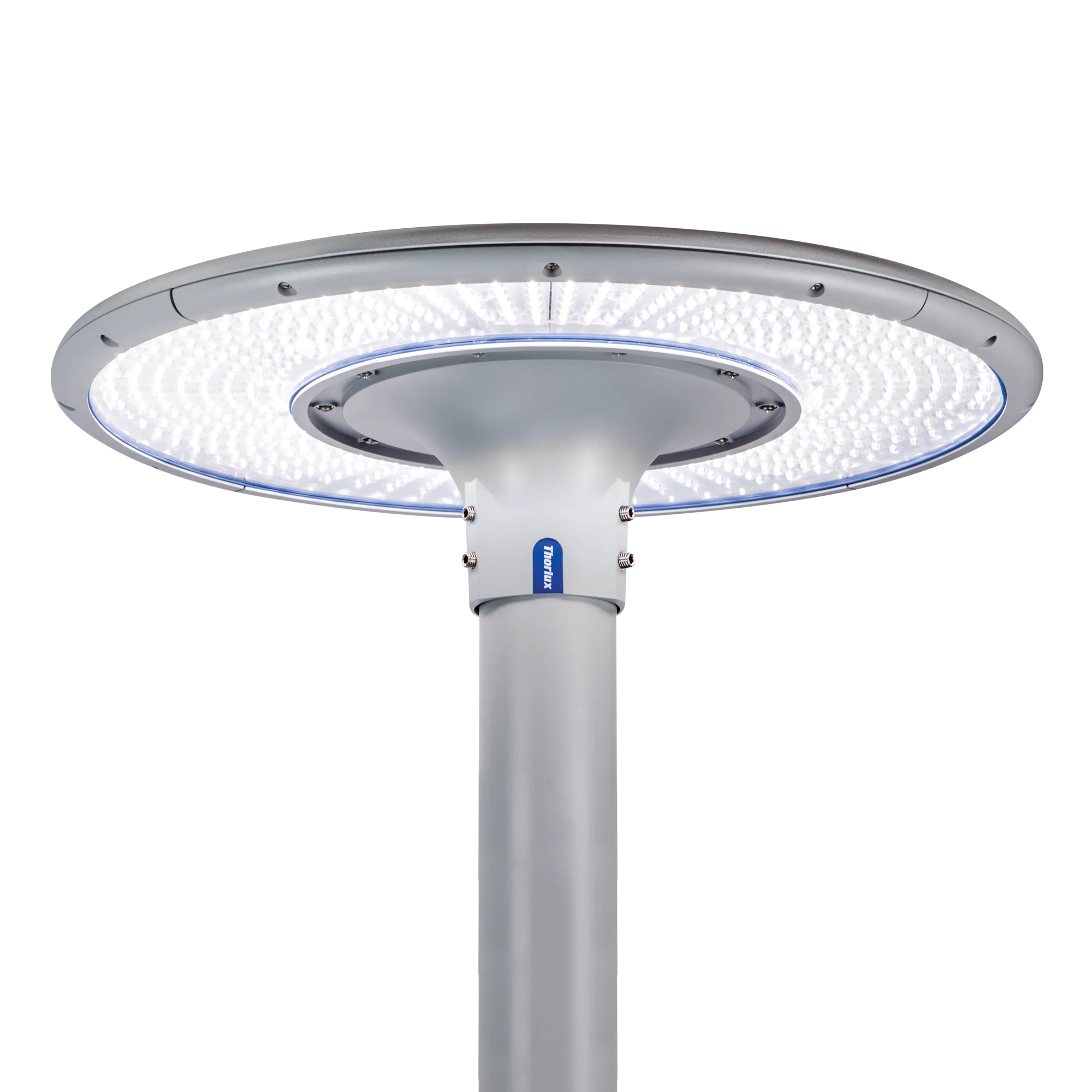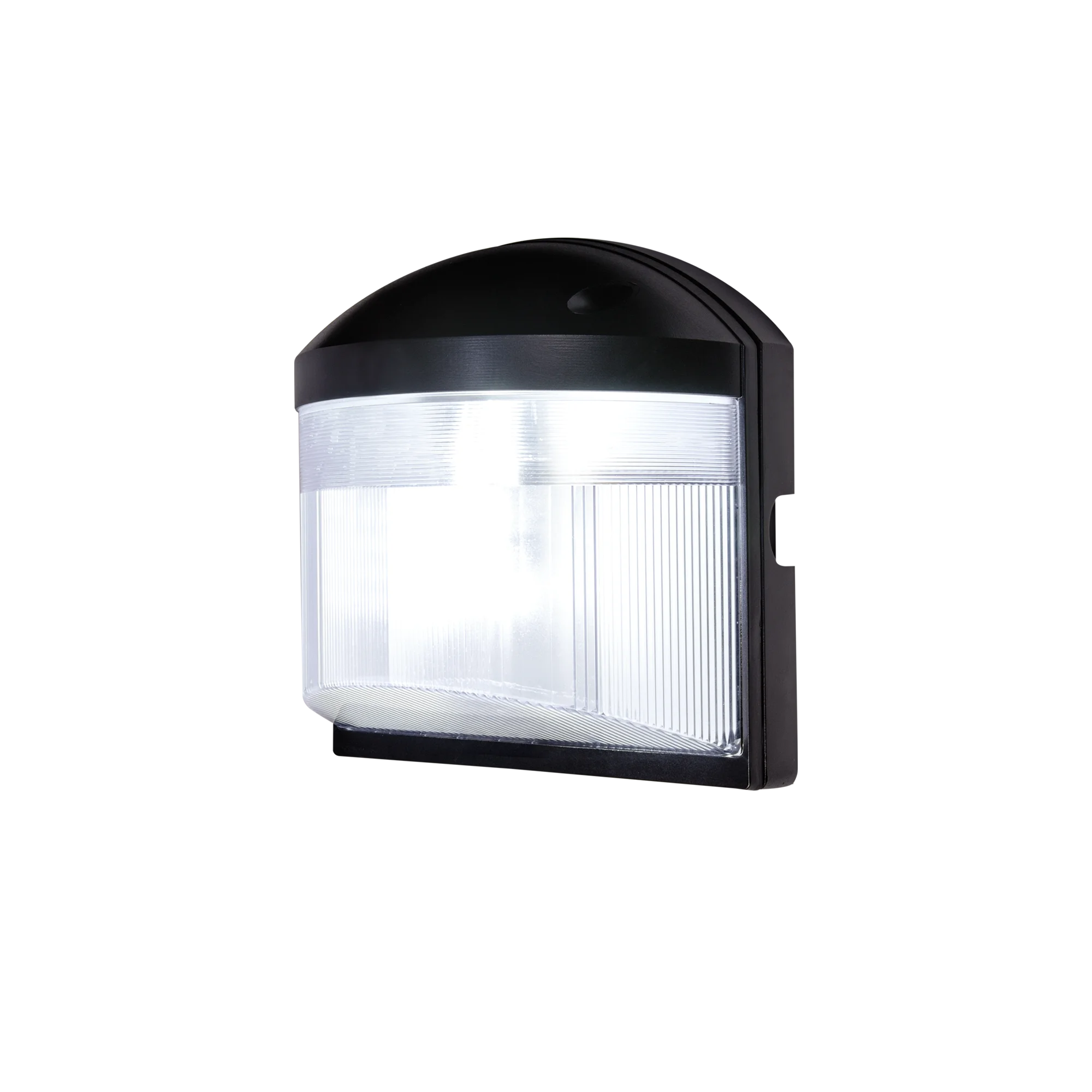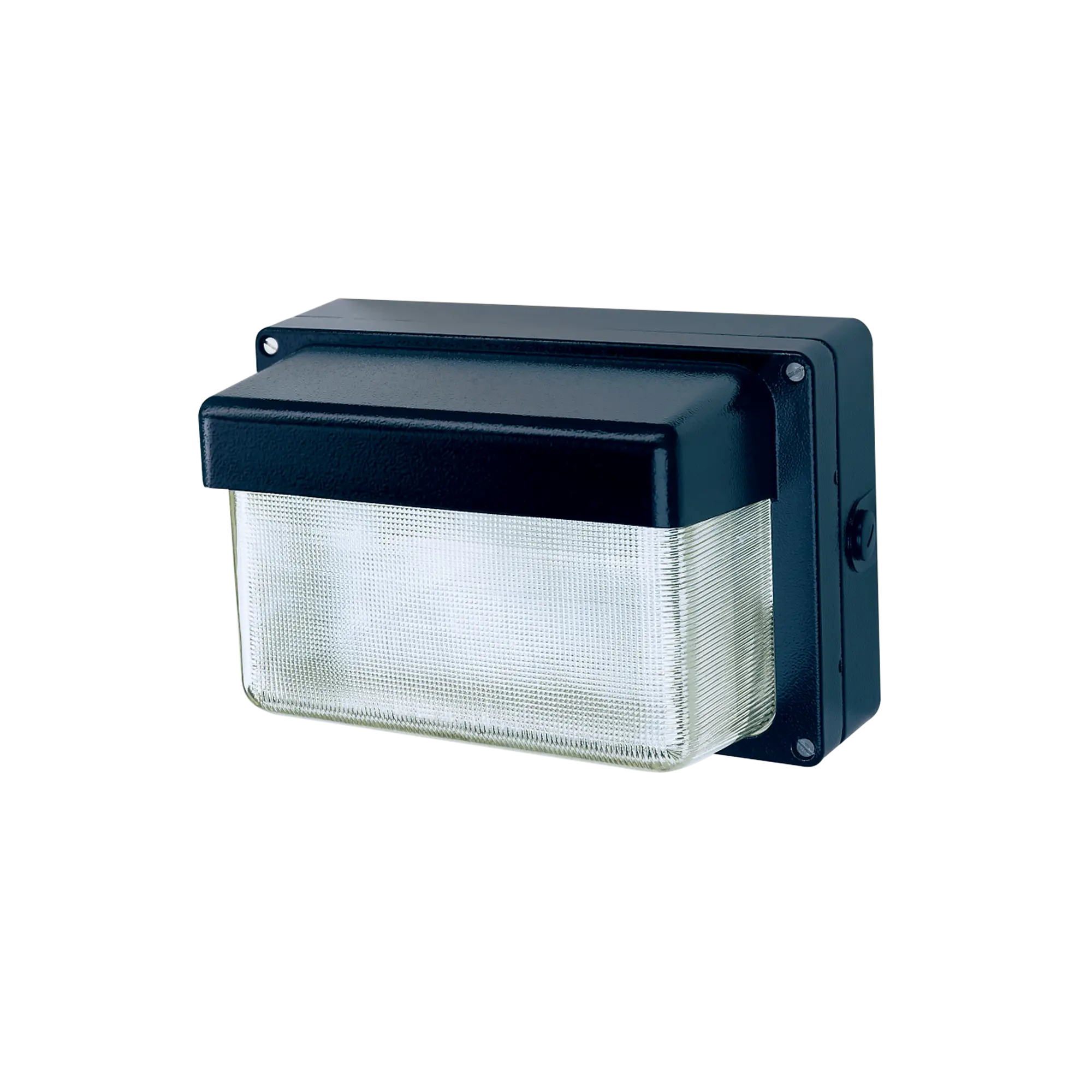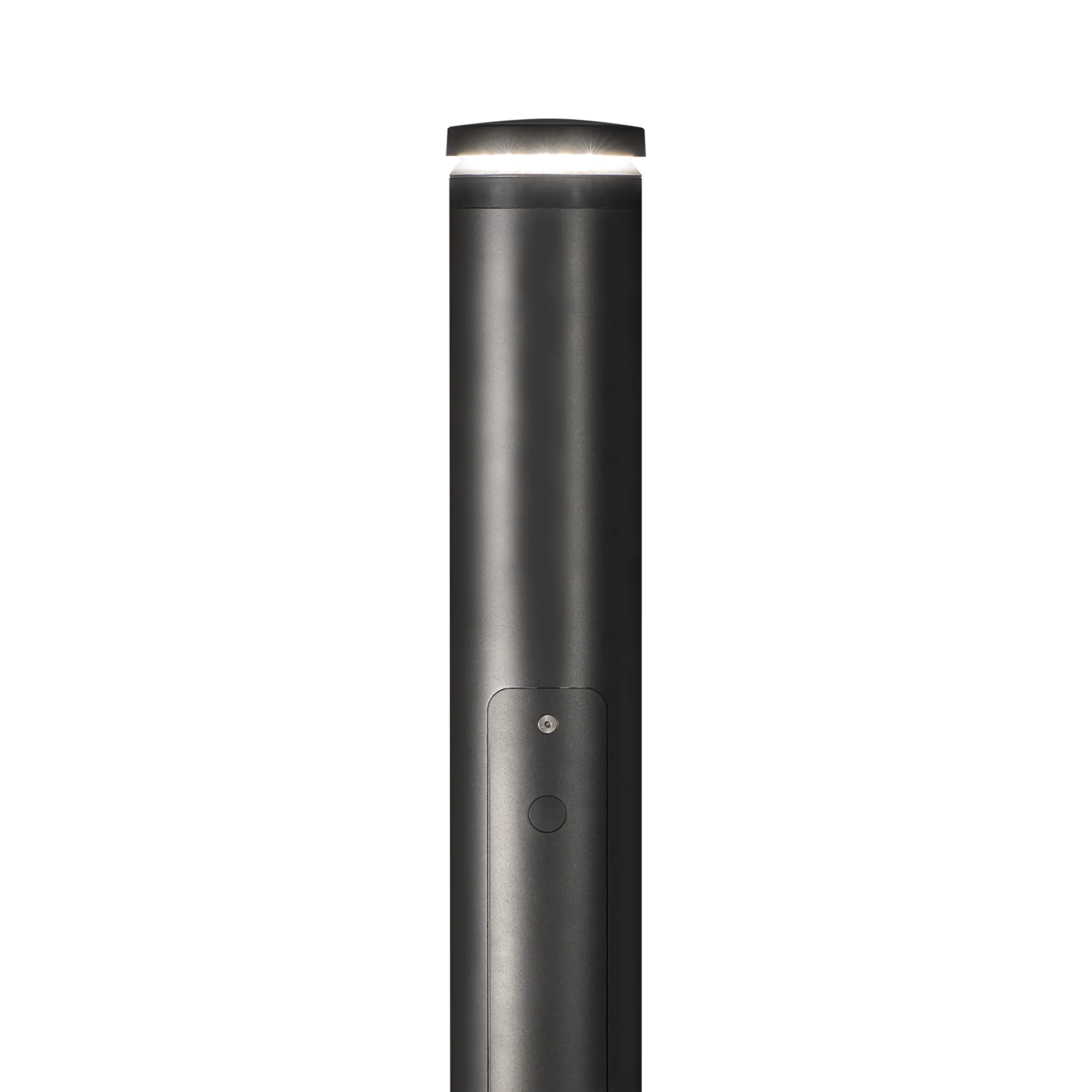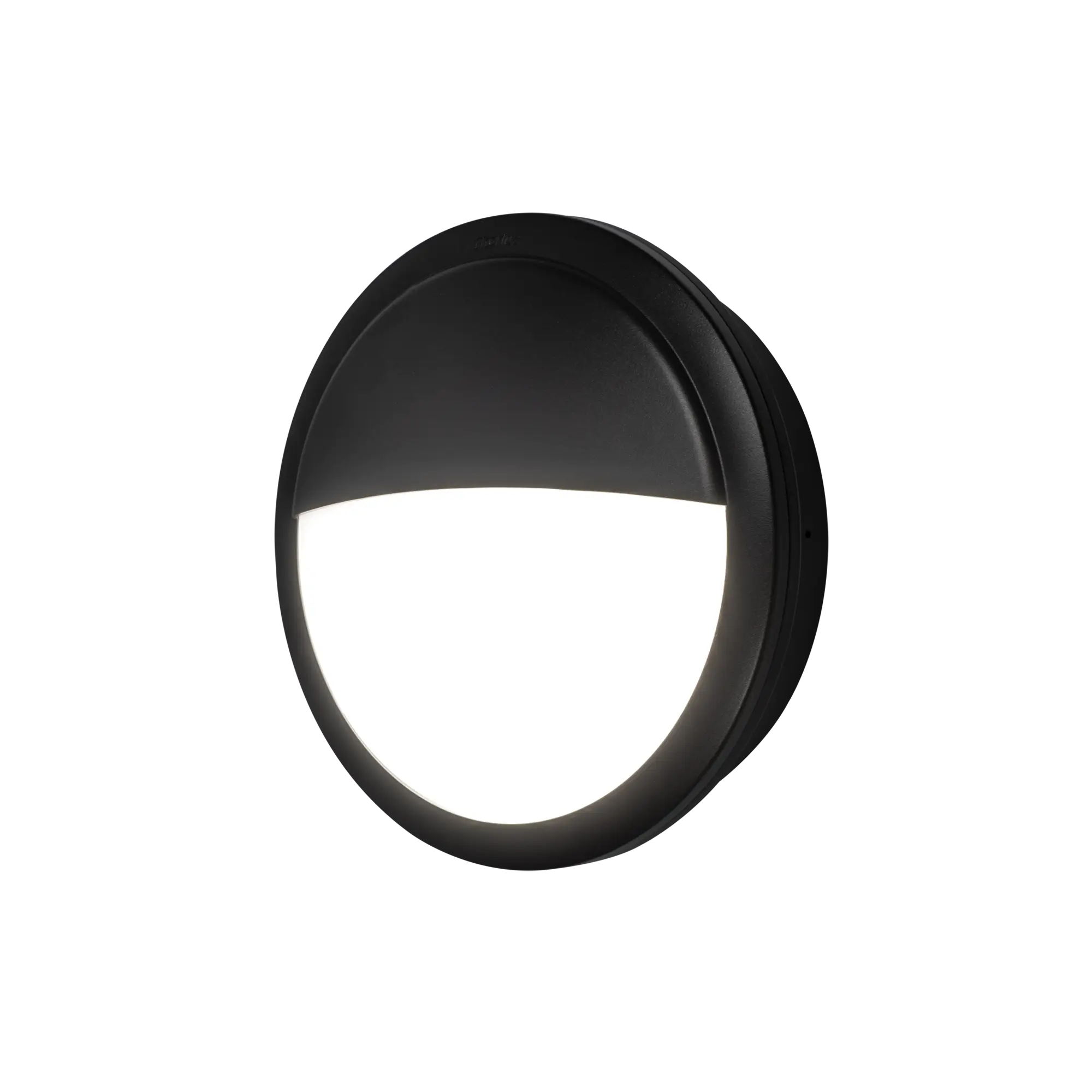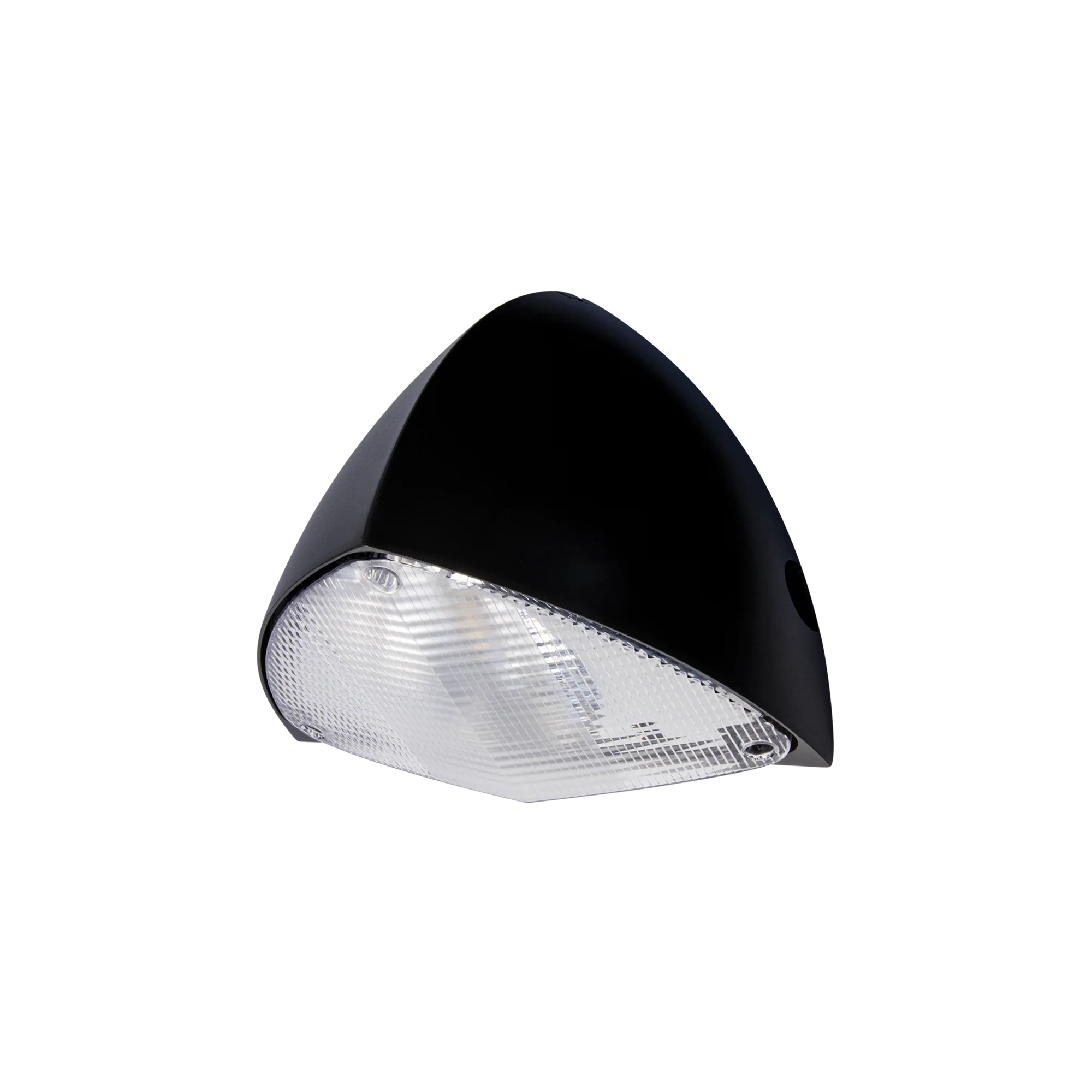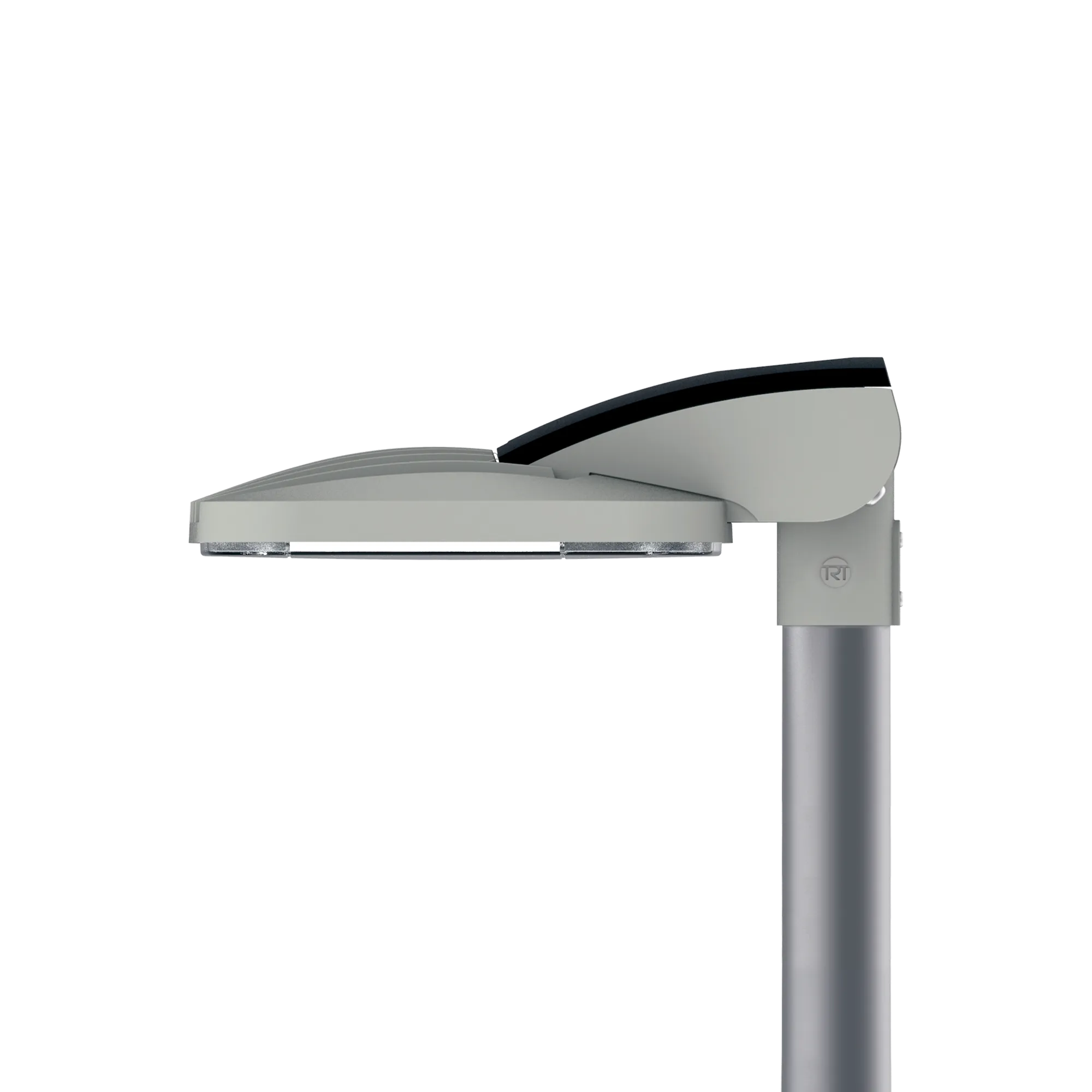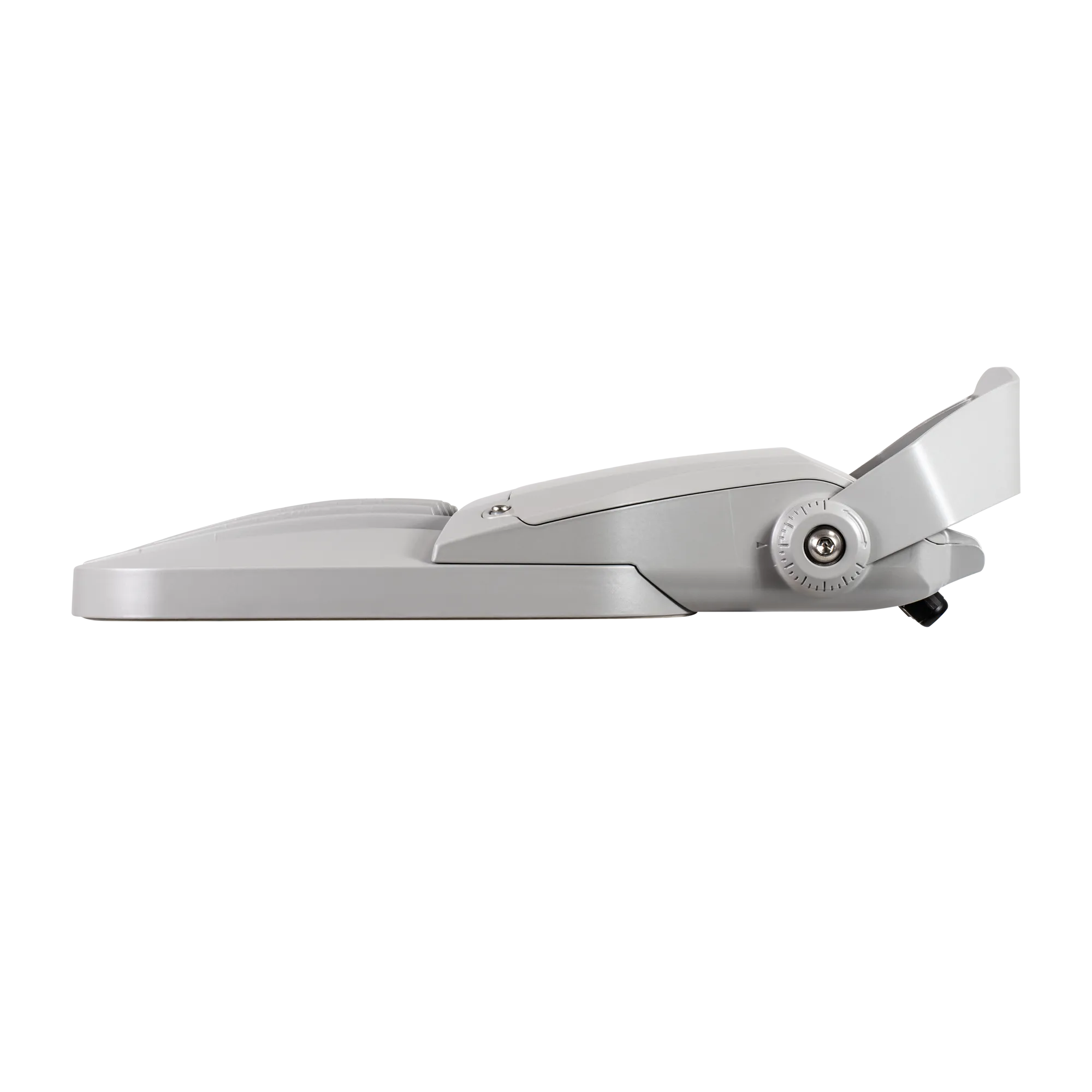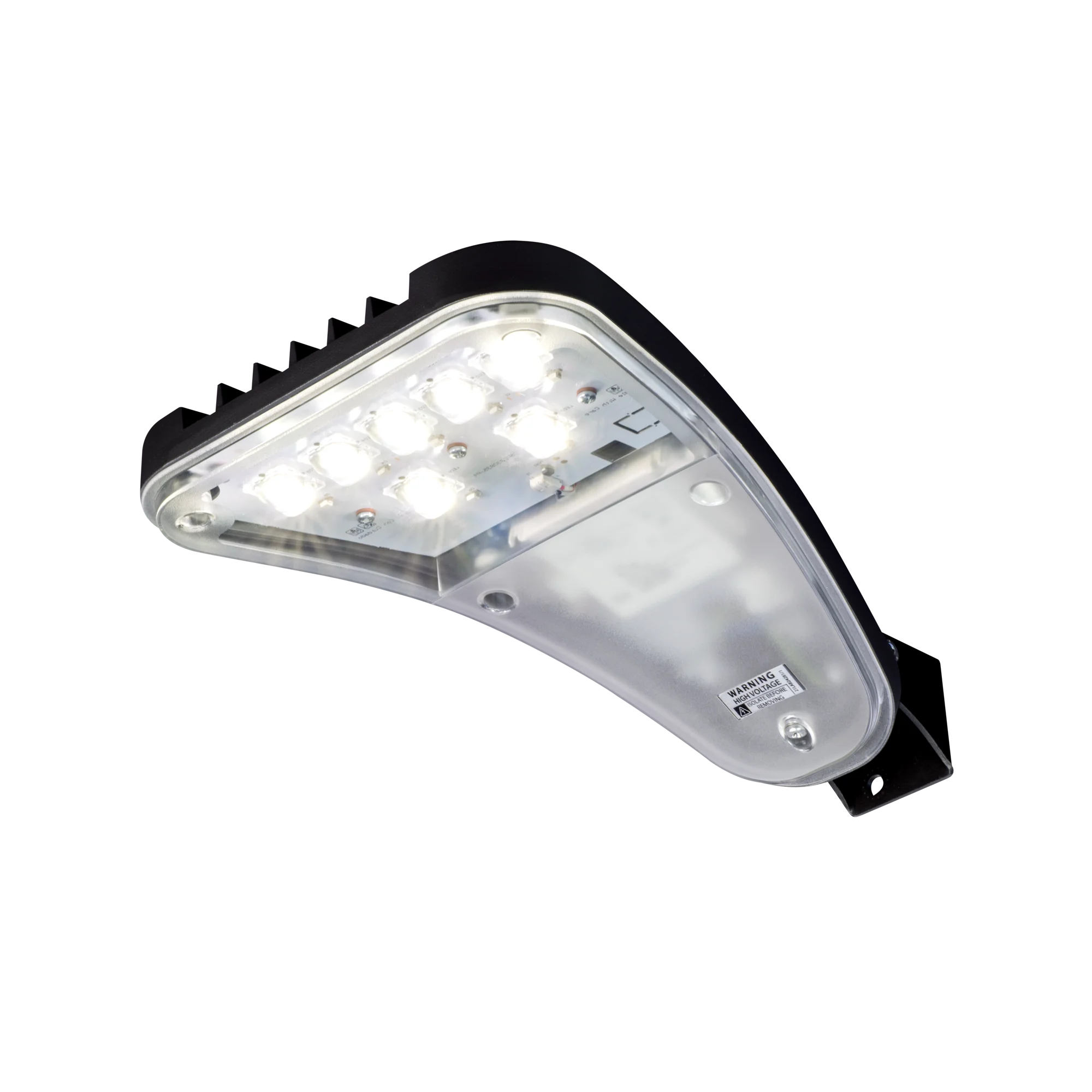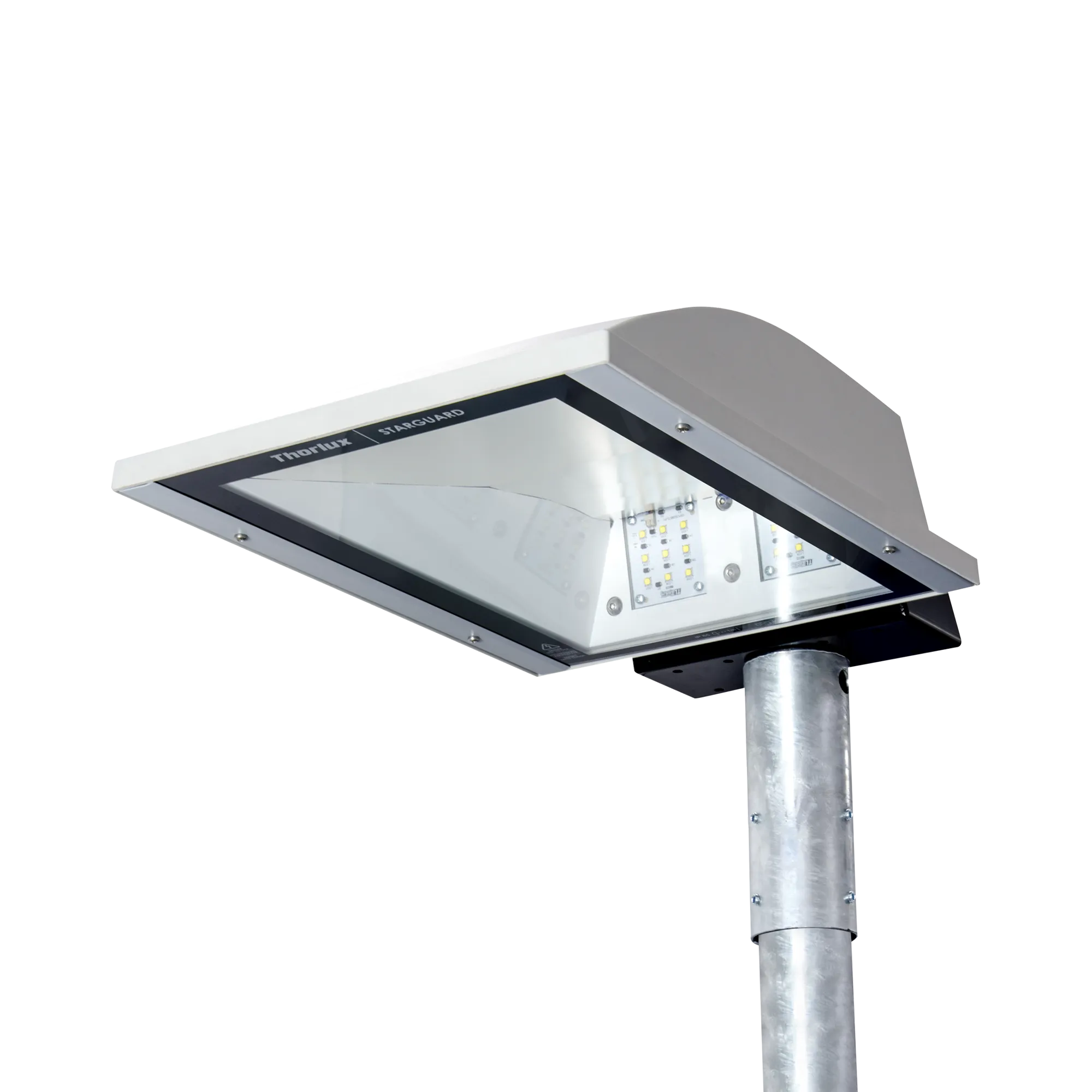External
External car parks need to be illuminated to ensure safe movement for both vehicles and pedestrians, and to provide an essential security function. Suitable weatherproof luminaires should be used, most often mounted on columns.
Choice of Luminaire
A number of factors need to be considered:
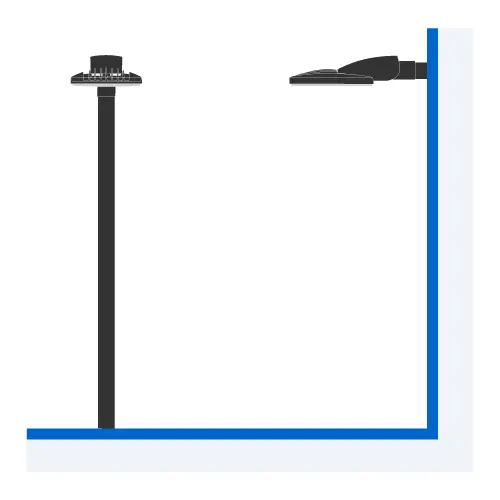
Wall mounted or on columns.
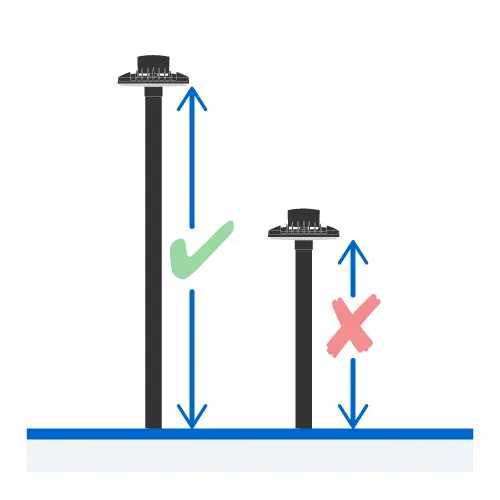
The optimum mounting height.
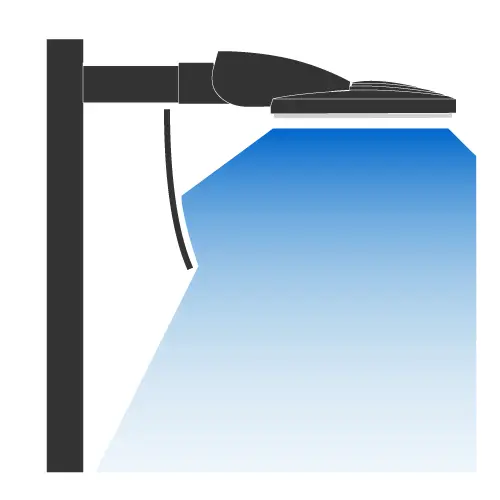
Spill lighting avoidance, particularly in suburban areas, where lighting falling onto neighbouring gardens or windows must be avoided.
Illumination Levels
The illumination level is dependent upon the usage level and the crime risk of the location. (See table)
| Application | Minimum maintained mean illuminance (lux) | Illuminance uniformity (minimum/average) | Notes |
|---|---|---|---|
| Light traffic and low crime risk car parks | 5 | 0.25 | The illuminance is measured on the ground, using the method given in BS 5489-1:2020 |
| Medium traffic and medium crime risk car parks | 10 | 0.25 | |
| Heavy traffic and medium crime risk car parks | 20 | 0.25 |
Ingress Protection
External luminaires need to be sealed properly to avoid ingress by rain and insects. The IP rating of Thorlux’ external luminaires is established in our own laboratory and is typically IP65 or 66. This protects the electronic components against moisture damage, and prevents insects from entering the luminaire.
New Installations
Luminaires are available with a range of distributions that can be matched to the site requirements, some are designed for area lighting with good forward throw whilst others provide wide distribution for pathways and roadways.
Luminaires with wide-spacing characteristics should be selected in order to reduce the number of columns to be installed, and to reduce energy consumption.
The Starflood light output is over 5,400 lumens, making it ideal for smaller spaces. For larger areas, the Starbeam is ideal because it is available with both area and roadway distributions in a range of outputs up to 30,000 lumens.
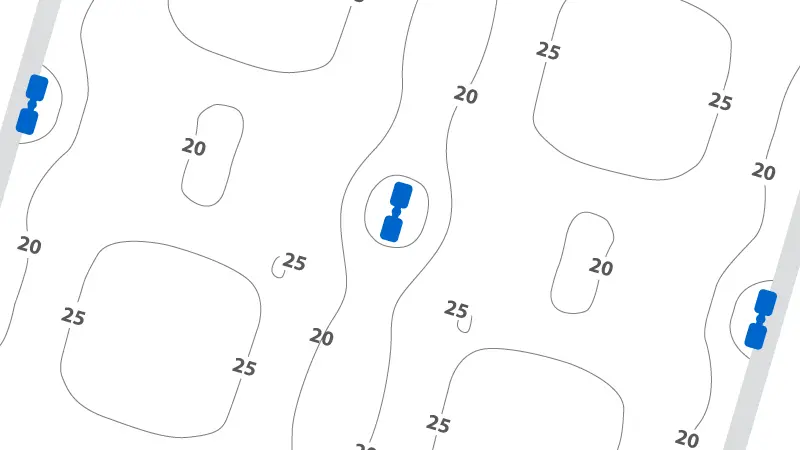
Retrofit onto existing columns
To avoid the cost and complication of moving columns, the objective is to use luminaires that will provide the correct output and distribution to evenly illuminate the space to the required level. Upgrading from a discharge lamp to LED technology will offer:
- Reduced energy consumption. A typical LED external luminaire produces 120 LL/CW, compared to about 50-70 LL/CW for a comparable SON luminaire
- Better colour rendition
- Much longer life - typically 100,000 hours vs 15,000 hours (70W SON)
- Instant illumination compared to 2-4 minutes warm up for a discharge lamp
The Juno range is ideal for one-for-one replacement of older discharge lanterns. Each LED is fitted with an individual lens to ensure light is distributed accurately to provide even illumination levels and to maximise spacings between lanterns. Juno A and Juno C are ideal for mounting heights up to 6m, Juno B up to 10m.

Large Supermarket and Shopping Centre Car Parks
These are often lit with high pressure sodium luminaires on very tall columns - typically 10 or 12m. Access can often be a significant issue because of the mounting height, and the requirement to close-off a number of parking bays to accommodate access equipment.
Luminaires with suitable distribution are needed to match the existing column locations. However if the supermarket is close to residential areas, spill lighting needs to be considered so as to avoid nuisance lighting.
Juno D is an ideal replacement for these applications. Juno D has a 100,000 hour rated life, so maintenance is reduced, and running costs are minimised due to high luminaire efficiency (121.9 LL/CW).
The luminaire’s square distribution pattern is achieved by lenses fitted to every LED which produces a very uniform illumination level, making it ideal for car parking applications. An asymmetric version, with reduced backward output, is ideal for perimeter locations to minimise spill lighting.
Bollards
Bollards are suitable for lighting pedestrian and cycle paths in urban areas. They provide a low level lighting solution without the need for tall columns which might spoil the aesthetic and increase spill lighting into adjacent gardens and properties.
However, bollards are at risk of damage by vandalism so need to be used with care, and poorly designed optics result in glare, poor uniformity and closer spacings.
Passway, launched at the end of 2019, is a contemporary, highly robust and optically refined LED bollard that is designed to protect itself and those around it. Passway uses a dedicated lens for each LED to ensure the most efficient distribution of light resulting in highly impressive luminaire spacings whilst still maintaining uniformity.
External Lighting Management
SmartScan External offers control features that reduce energy wastage, without compromising safety and security. These include:
- Presence detection to ensure lighting is on when needed, and switched off (or dimmed down) when the car park is not in use.
- Light detection to ensure car park lights are off during the day.
- Time-based control for maximum flexibility.
 Find out more
Find out more
Emergency Lighting
BS 5266-1 recommends emergency lighting to be provided outside a building from the emergency exits to a place of safety. Therefore a Risk Assessment should determine where external emergency lighting is required.
The Realta Micro, with its downward light distribution is well-suitable for use as an external bulkhead over a final exit door to illuminate the immediate area.
Self-contained emergency versions of the Starbeam lantern and the Passway bollard can be used to illuminate external routes.
